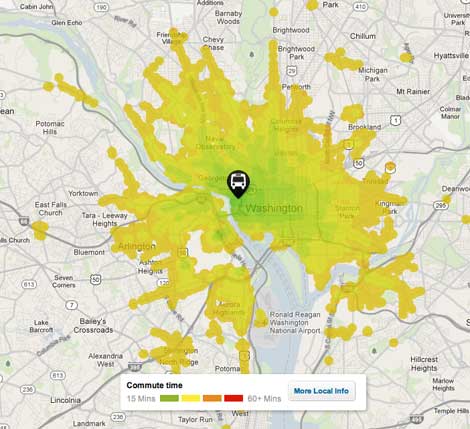If you lived at the Watergate, this is how long your commute would be around the city by car. Good news is that should you be heading to, say, the White House, you can get there in about 10 minutes. (Probably faster under cover of darkness.)

Should you choose instead to travel by public transit, the trip takes slightly longer, but it’s easier to blend in with crowds.

These images were generated by Trulia’s awkwardly named “Visual analysis of local data” tool, henceforth known as the Commute-o-matic.™ It’s less complicated than it seems. The tool looks at known public transit routes (bus stops, train stations) and the travel times between them. What makes it look magical is the speed with which it makes the calculations.
In most cities, you can almost always get more places in less time by car. That revelation won’t shock you, though the extent of the problem might. Compare San Jose with San Francisco. Huge difference in what public transit allows.
This may become more of a problem. Particularly since the economic downturn in 2008, Americans have been buying fewer cars. Fewer and fewer households have second cars, meaning that for multiple working adults, more will rely on public transportation.
That’s good news — unless you live in a city with a small travel footprint for transit. Or, worse: a shrinking one. We wrote earlier this month about the impact cuts to transit are having on Pittsburgh’s job creation. The cuts the city is making can already be blamed for one company’s failure to add new employees, but it’s easy to see how that impact can ripple.
Investment does more than facilitate people getting to jobs. It also creates new ones. A recent study by the Economic Policy Institute found that increased investment in public transit in Los Angeles would bear economic benefits in multiple ways. In addition to expanding access for residents to find jobs (an area in which certain parts of the city already do well), the construction itself would put a lot of people to work. The purchase of new American-made railcars alone could generate up to 8,200 new jobs, including 2,400 in the region. A March report from the Department of the Treasury [PDF] indicates that the breakdown of job type by sector from infrastructural investment is:

The Congress is working to develop a compromise bill on transportation funding (which we’ll have more on over the course of the week). An estimate of the impact of investment proposed by the Senate indicates that 2.9 million jobs will be created or saved [PDF] with strategic investment. 390,000 new jobs would be created in transit alone. That’s the abstract.
In the practical sense, broad investment in public transit in particular opens up cities for job-seekers — and everyone else. The main lesson from the Commute-o-matic™ isn’t that we should move places that have easier commutes — it’s that we have a lot more work to do to make commutes as easy and common as possible.




